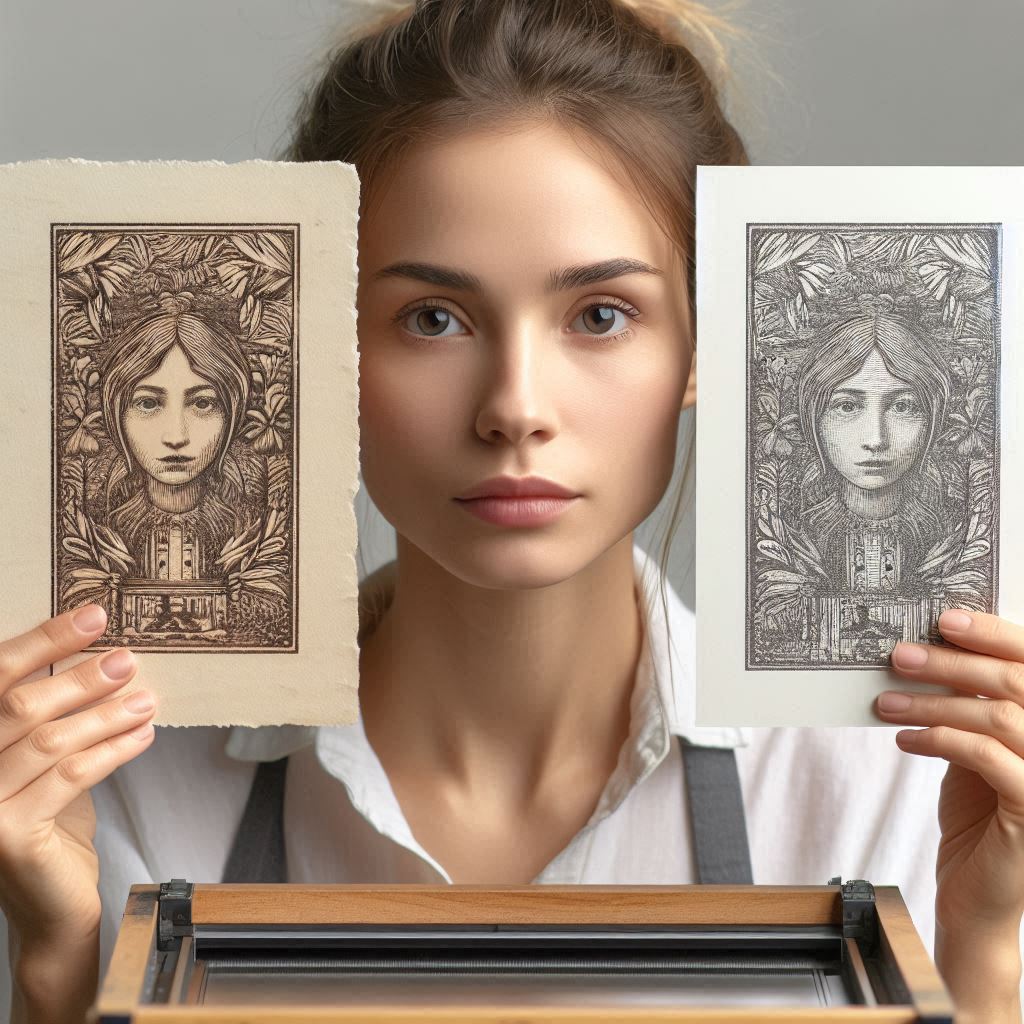Introduction
Printmaking and digital printing represent two distinct methods of producing images.
Each method has its own unique processes and historical significance.
This blog post will explore these differences in detail.
Printmaking has deep roots in art history.
Traditional printmaking includes techniques like engraving, etching, and lithography.
These methods have been used for centuries, offering artists a way to reproduce their work in multiple copies.
The process involves creating a matrix, applying ink, and pressing it onto paper.
This method allows for intricate textures and details.
Digital printing, on the other hand, is a modern technology.
It emerged in the late 20th century with the rise of computers and digital devices.
This method uses digital files and printers to produce images.
It allows for quick, high-quality prints and offers flexibility in design.
Digital printing is widely used today, from producing high-resolution photographs to customized marketing materials.
In this blog post, we will first compare the techniques of printmaking and digital printing.
Next, we will discuss the advantages and limitations of each method.
Finally, we will explore how these methods impact artists and businesses today.
By understanding these differences, you can make informed choices about which printing method best suits your needs.
Whether you’re an artist looking for traditional techniques or a business seeking efficient digital solutions, this post will provide valuable insights.
Definition and Process of Printmaking
Printmaking and the traditional process
Printmaking is a traditional art form that involves creating images by transferring ink onto surfaces.
This process starts with an artist preparing a plate or block.
Transform Your Career Today
Unlock a personalized career strategy that drives real results. Get tailored advice and a roadmap designed just for you.
Start NowThey then apply ink to this plate and press it onto paper or fabric.
This method produces multiple copies of the same image, each one unique due to slight variations in the printing process.
The different types of printmaking techniques such as etching, lithography, and screen printing
There are several techniques within printmaking, each with distinct methods and effects.
Etching involves scratching a design into a metal plate covered with a waxy ground.
The plate is then dipped in acid, which eats away the exposed metal.
The artist inks the plate and wipes off excess ink, leaving ink only in the etched lines.
This produces detailed, textured prints.
Lithography uses a flat stone or metal plate.
The artist draws on the plate with a greasy substance.
The plate is then chemically treated so that oil-based ink adheres only to the drawn areas.
This method allows for a wide range of textures and tones.
Screen printing involves pushing ink through a mesh screen onto a surface, usually paper or fabric.
The areas where ink should not go are blocked off with a stencil or emulsion.
This technique is popular for its versatility and ability to produce vibrant colors and bold graphics.
The tactile and unique qualities of printmaking
Printmaking is cherished for its tactile and unique qualities.
Each print has a distinct texture and depth that digital printing cannot replicate.
The physical interaction with the materials during the process results in prints that feel handcrafted.
This distinctiveness and tangible quality make printmaking a valued artistic method, offering a sensory experience that digital methods lack.
Read: How to Start a Career as a Ceramic Artist
Definition and Process of Digital Printing
Digital printing and the modern process
Digital printing refers to methods that transfer digital files directly onto various media.
Transform Your Career Today
Unlock a personalized career strategy that drives real results. Get tailored advice and a roadmap designed just for you.
Start NowUnlike traditional printing, it doesn’t use plates.
Modern digital printing involves several key steps.
First, the digital file, such as a PDF, is prepared and optimized.
The file is then sent to the printer, which uses inkjet or laser technology to apply the image onto the paper or other substrates.
This process allows for precise and vibrant color reproduction.
Use of technology and digital software in digital printing
Technology plays a crucial role in digital printing.
Advanced digital printers utilize high-resolution print heads to ensure sharp, clear images.
Software programs manage color calibration, layout, and print quality.
These tools allow for customization and adjustments to achieve the desired outcome.
Speed and efficiency of digital printing
Digital printing stands out for its speed and efficiency.
Unlike traditional methods that require setup time and plate-making, digital printing offers rapid turnaround.
It is ideal for short runs and on-demand printing, making it a cost-effective choice for many businesses.
The ability to print directly from digital files reduces production time and minimizes waste.
Digital printing also supports variable data printing, which allows for personalized or customized prints without additional setup costs.
In summary, digital printing harnesses modern technology to streamline the printing process.
Its efficiency, coupled with advanced digital software, makes it a preferred choice for quick and high-quality print jobs.
Read: How to Build a Printmaking Portfolio
Quality of Output
Printmaking and digital printing offer distinct quality outputs.
Printmaking often excels in producing rich, textured results with a handmade feel.
Digital printing delivers high precision and consistent quality, making it ideal for reproducing fine details and vibrant colors.
Transform Your Career Today
Unlock a personalized career strategy that drives real results. Get tailored advice and a roadmap designed just for you.
Start NowEach method has its strengths and appeals to different aesthetic preferences.
The Unique Textures and Imperfections of Printmaking
Printmaking creates unique textures and subtle imperfections that add character.
Techniques like etching, lithography, and screen printing involve physical processes, resulting in varied surfaces and depth.
These imperfections, such as slight color variations or irregular edges, contribute to the artwork’s charm and individuality.
Each print is slightly different, reflecting the hands-on nature of the process.
Crisp and Precise Details of Digital Printing
Digital printing stands out for its sharp, precise details.
It uses advanced technology to ensure consistent color accuracy and clarity.
Digital printers excel at reproducing intricate designs and fine lines with exacting precision.
This method is perfect for projects requiring high-resolution images and uniform results across multiple copies.
The absence of physical texture means each print looks identical, offering a sleek and professional finish.
In a nutshell, printmaking offers unique textures and individual characteristics, while digital printing provides unmatched precision and consistency.
Choosing between the two depends on whether you value the tactile qualities of traditional printmaking or the exacting detail of digital technology.
Read: How to Price Your Character Design Work as a Freelancer

Cost and Accessibility
The Cost Implications of Printmaking vs. Digital Printing
Printmaking and digital printing vary significantly in cost.
Printmaking often involves higher initial expenses.
Artists must invest in tools like presses, plates, and inks.
Additionally, printmaking requires labor-intensive processes that can drive up costs.
On the other hand, digital printing offers lower upfront costs.
It primarily requires a good quality printer and software.
However, digital printing costs can rise with high volume and frequent use.
Transform Your Career Today
Unlock a personalized career strategy that drives real results. Get tailored advice and a roadmap designed just for you.
Start NowFor small runs or single prints, digital printing is usually more cost-effective.
The Materials and Equipment Needed for Each Method
Printmaking demands a range of specialized materials and equipment.
Essential items include plates or blocks, carving tools, presses, and various inks.
These materials can be expensive and require space for setup and storage.
Digital printing, in contrast, needs fewer physical materials.
Basic requirements include a computer, digital files, and a printer.
The cost of ink and paper is generally lower than that for printmaking materials.
Digital printing equipment tends to be more compact, making it easier to set up and manage.
The Accessibility of Digital Printing in Comparison to Printmaking
Digital printing is notably more accessible than printmaking.
The technology is widely available and user-friendly, allowing anyone with a computer and printer to produce prints.
Digital files can be easily shared and printed on-demand, enhancing convenience.
Printmaking, however, often requires specialized knowledge and access to dedicated studio space.
Setting up a printmaking studio can be complex and costly.
Thus, while digital printing offers greater accessibility and ease of use, printmaking demands more investment and expertise.
Read: Top Printmaking Tools for Beginners
Environmental Impact
Printmaking and digital printing each have distinct environmental impacts.
Understanding these can guide more sustainable choices.
Printmaking Materials: Inks and Plates
Traditional printmaking often involves inks made from solvents and chemicals.
These substances can emit volatile organic compounds (VOCs), which contribute to air pollution.
Additionally, metal plates used in processes like intaglio can be resource-intensive and require significant energy to produce and dispose of.
Transform Your Career Today
Unlock a personalized career strategy that drives real results. Get tailored advice and a roadmap designed just for you.
Start NowSome printmaking techniques use environmentally friendly inks and plates, but these are not universally adopted.
Energy Efficiency: Printmaking vs. Digital Printing
Printmaking typically involves labor-intensive processes, often requiring energy for heating and press operations.
Large print runs can be energy-efficient, but each setup requires considerable initial energy.
In contrast, digital printing uses electricity but is more efficient for smaller runs.
Digital presses eliminate many of the steps involved in traditional printmaking, reducing overall energy consumption.
This makes digital printing generally more energy-efficient, especially for short-run or on-demand printing.
Sustainability of Digital Printing
Digital printing technology has made strides in sustainability.
Modern digital printers use eco-friendly inks and recyclable materials.
They also produce less waste, as they eliminate the need for plates and minimize excess prints.
Digital printing allows for precise, on-demand production, reducing overproduction and excess inventory.
Advances in technology continue to improve the environmental footprint of digital printing.
Basically, while traditional printmaking has a notable environmental impact due to its materials and processes, digital printing offers a more sustainable alternative.
Explore Further: Balancing Art and Commerce in Textile Design
Customization and Reproducibility
Printmaking and digital printing each offer unique advantages in customization and reproducibility.
Understanding these differences helps artists and businesses choose the best method for their needs.
Customization in Printmaking
Printmaking excels in customization.
Artists can control every detail of the print process.
Techniques like etching, woodcut, and linocut allow for one-of-a-kind textures and details.
Each print can be unique due to slight variations in handcrafting.
This level of control ensures that every piece stands out.
Transform Your Career Today
Unlock a personalized career strategy that drives real results. Get tailored advice and a roadmap designed just for you.
Start NowCustomization in printmaking often reflects an artist’s personal touch.
Reproducibility in Printmaking
Printmaking offers limited reproducibility.
While artists can produce multiple prints, each one carries unique characteristics.
Variations in ink application, pressure, and paper texture make each print distinct.
This uniqueness is prized by collectors.
However, if exact copies are needed, printmaking might fall short.
The process is more suited for creating limited editions.
Reproducibility in Digital Printing
Digital printing excels in reproducibility.
Once a digital file is created, it can be replicated with precision.
Every print is identical, which is ideal for high-volume production.
This method ensures uniformity in color and detail.
Digital printing also allows for easy edits and adjustments to the artwork.
This consistency is valuable for businesses requiring large quantities of the same design.
Mass Production in Digital Printing
Digital printing is unmatched for mass production.
Its efficiency in reproducing large quantities is a significant advantage.
Businesses can produce thousands of copies quickly and economically.
This method supports a high volume of prints without sacrificing quality.
Additionally, digital printing supports on-demand production, reducing waste and storage costs.
All in all, printmaking offers unmatched customization with limited reproducibility, while digital printing excels in producing identical copies and mass production.
Each method has its strengths, making them suitable for different applications and needs.
Transform Your Career Today
Unlock a personalized career strategy that drives real results. Get tailored advice and a roadmap designed just for you.
Start NowFind Out More: Case Studies: Successful Packaging Design Projects
Artist Preferences and Trends
The preferences of contemporary artists towards printmaking or digital printing
Contemporary artists are increasingly drawn to either printmaking or digital printing, each offering unique possibilities.
Printmaking retains a strong following due to its traditional techniques and tactile qualities.
Many artists appreciate the hands-on process of carving, inking, and pressing.
This method offers a distinct texture and depth that digital printing often cannot replicate.
The historical context of printmaking also appeals to artists who value its long-standing artistic traditions.
On the other hand, digital printing is gaining popularity for its precision and versatility.
Artists are attracted to its ability to produce high-quality prints with fine details and vibrant colors.
Digital tools also allow for easier manipulation of images and quicker production times.
The convenience of digital printing makes it appealing for artists who work in fast-paced environments or on large-scale projects.
Emerging trends in the usage of these methods
Emerging trends indicate a growing fusion of both techniques.
Artists are experimenting with mixed media approaches, integrating digital elements into traditional printmaking processes.
This combination allows for innovative results and new aesthetic possibilities.
For instance, some artists use digital technology to create intricate designs that are then rendered through traditional printmaking methods.
This hybrid approach can offer the best of both worlds, blending the tactile quality of printmaking with the precision of digital tools.
Examples of artists who successfully combine both techniques
One notable example is artist Kehinde Wiley, who combines digital and traditional techniques to produce striking portraits.
His process often starts with digital sketches, which he then translates into vibrant prints using traditional methods.
Similarly, artist Tara Donovan uses digital technology to generate patterns that are later realized through physical materials and traditional techniques.
The evolving landscape of printmaking and digital printing highlights an exciting era of experimentation.
Artists are leveraging both methods to push creative boundaries and explore new artistic frontiers.
Transform Your Career Today
Unlock a personalized career strategy that drives real results. Get tailored advice and a roadmap designed just for you.
Start NowLearn More: Understanding Fashion Design Runway Shows
Conclusion
Printmaking and digital printing have key differences that set them apart.
Printmaking involves creating images through various techniques like etching, engraving, and lithography.
On the other hand, digital printing involves using a computer to reproduce images on paper or other materials.
It is essential to understand the unique characteristics of each method.
Printmaking offers a hands-on approach that allows for customization and experimentation.
Digital printing, on the other hand, provides precision and efficiency in reproducing complex designs with vibrant colors.
For artists and designers, it is important to experiment with both techniques to find what works best for their own artistic practice.
By exploring printmaking and digital printing, creatives can harness the strengths of each method to enhance their work and achieve their artistic vision.




